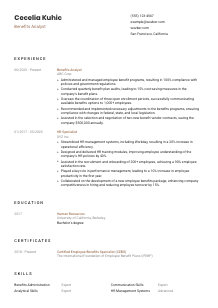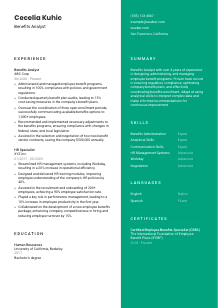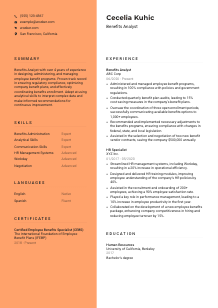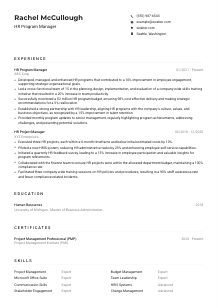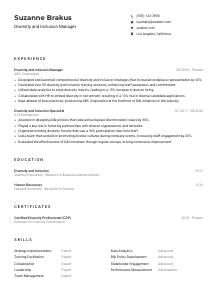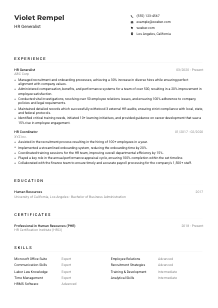Benefits Analyst Resume Example
Unraveling perks, but your resume doesn't look enticing? Peruse this Benefits Analyst resume example, assembled with Wozber free resume builder. Learn how to meld your aggregation acumen with job-specific advantages, turning your career trajectory into one exhilarating benefits package!
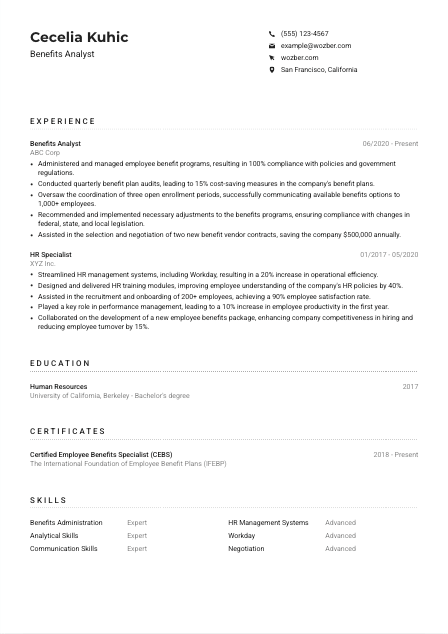
How to write a Benefits Analyst Resume?
Navigating the path to becoming a standout Benefits Analyst begins with one crucial step: drafting a resume that doesn't just speak to your capabilities, but shouts them. Don't let your resume be the barrier between you and your dream job. With Wozber's free resume builder, you're about to embark on a journey to transform your resume into a laser-focused, ATS-optimized masterpiece. Let's dive into how to meticulously fashion each section of your resume, ensuring it's perfectly aligned with your desired Benefits Analyst position.
Personal Details
First impressions matter. The Personal Details section is the initial handshake with your potential employer, setting the tone for the rest of your resume. Let's tailor this area specifically to make you an irresistible candidate for the Benefits Analyst role.
1. Name with Flair
Your name is your headline. Consider font size and style that makes your name visibly stand out, subtly saying, 'I'm the Benefits Analyst you're searching for.'
2. Job Title Just Below Your Name
By adding ‘Benefits Analyst' right below your name, you're aligning with the job right off the bat. It's like saying, 'Hello, I'm the perfect fit for this role.' This instant alignment with the job title helps set the stage for the rest of your resume.
3. Essential and Accurate Contact Details
List your phone number and a professional email address. Simple and professional is the key – think firstname.lastname@email.com. Ensuring these details are accurate is vital; you don't want to miss a call or email from your dream job.
4. Location, Location, Location
Including 'San Francisco, California' not only shows you're in the right place but also saves recruiters' time by confirming your eligibility regarding the location requirement upfront.
5. A Professional Profile Worth a Click
A link to your LinkedIn profile or personal website can provide a deeper insight into your professional world. Make sure they are up-to-date and mirror the accomplishments and skills you're about to showcase on your resume.
Takeaway
Think of the Personal Details section as the firm handshake before a deep conversation. It's your first opportunity to resonate with the role and show you're in sync with the job requirements. Craft it with care, ensuring you present the most essential and aligned version of yourself.





Experience
Your Experience section is where your resume starts to truly sparkle. It's your career storybook, filled with tales of achievements, challenges conquered, and the vast landscapes of HR and benefits you've navigated. Carving out a meticulously detailed and ATS-optimized narrative here is key for the Benefits Analyst role.
- Administered and managed employee benefit programs, resulting in 100% compliance with policies and government regulations.
- Conducted quarterly benefit plan audits, leading to 15% cost‑saving measures in the company's benefit plans.
- Oversaw the coordination of three open enrollment periods, successfully communicating available benefits options to 1,000+ employees.
- Recommended and implemented necessary adjustments to the benefits programs, ensuring compliance with changes in federal, state, and local legislation.
- Assisted in the selection and negotiation of two new benefit vendor contracts, saving the company $500,000 annually.
- Streamlined HR management systems, including Workday, resulting in a 20% increase in operational efficiency.
- Designed and delivered HR training modules, improving employee understanding of the company's HR policies by 40%.
- Assisted in the recruitment and onboarding of 200+ employees, achieving a 90% employee satisfaction rate.
- Played a key role in performance management, leading to a 10% increase in employee productivity in the first year.
- Collaborated on the development of a new employee benefits package, enhancing company competitiveness in hiring and reducing employee turnover by 15%.
1. Mirror the Job's Language
Pour over the job description and take note of the responsibilities and requirements. Use similar language when describing your own accomplishments. For instance, 'Administered and managed employee benefit programs' directly reflects the job description, making ATS and human eyes alike recognize the match.
2. Structure with Precision
List your jobs chronologically, starting with the most recent. Clearly lay out your job title, company name, and the span of your tenure. This clean structure is not only ATS-friendly but also makes it easy for hiring managers to scan through your career timeline.
3. Tailored Accomplishments
Highlight achievements with numbers to quantify your impact. If you've conducted audits resulting in cost-savings, mention it with figures, like, ‘leading to 15% cost-saving measures.' This specificity adds weight to your accomplishments and shows you speak in results.
4. Quality Over Quantity
Focus on experiences that align most closely with the Benefits Analyst role. You might be a superb karaoke singer, but unless it directly applies to analyzing benefits, keep the focus sharp on relevant responsibilities and wins.
5. The ATS-friendly Format
Formatting is not just about aesthetics; it's about accessibility too. Use an ATS-friendly resume template to ensure your valuable experience is easily parseable by both ATS and human reviewers. Clean formatting, standard fonts, and bullet points go a long way.
Takeaway
Each bullet point in your Experience section is a testament to your capability and dedication. This is your chance to shine, drawing direct lines between what you've done and what your future employer needs. With a tailored, quantified, and ATS-optimized section, you're telling the world: 'I'm not just a candidate; I'm the perfect fit.'
Education
While experience may be the jewel of your resume, education is the bedrock. For a Benefits Analyst, showcasing the right educational background paves a major part of your journey toward landing that role. Let's sculpt your Education section to affirm you have the knowledge foundation the job demands.
1. Match the Degree
The job description specifically asked for a 'Bachelor's degree in Human Resources, Business Administration, or related field.' Clearly list your degree, ensuring it aligns with this requirement. If your exact degree matches, you're already ahead in establishing relevancy.
2. A Clear Structure
Present your education clearly: degree, field of study, university name, and graduation year. This straightforward format is easy for ATS to scan and for human eyes to grasp, ensuring no guesswork for the hiring manager.
3. Highlight Relevant Extras
Did you excel in courses directly relevant to Benefits Analysis? While not the main attraction, succinctly listing these can add depth to your educational background, illustrating early focus and commitment to this field.
4. Showcase Achievements
Graduate cum laude? Member of the HR society? These little nuggets can give your resume personality and underscore your dedication and capabilities in the Human Resources domain, making you stand out as a well-rounded candidate.
5. Education and Certifications Connection
While the Education section focuses on formal university-based learning, don't hesitate to bridge to any certifications like the Certified Employee Benefits Specialist (CEBS) that further solidify your expertise in the benefits field.
Takeaway
Beyond a simple list of schools and degrees, your Education section can narrate the story of a committed, ambitious, and focused aspiring Benefits Analyst. Tailoring this section to the job requirements demonstrates your foundation is not only strong but directly relevant.
Certificates
In the world of HR and benefits, certifications can be a significant lever in setting you apart from the crowd. They signal to employers your commitment to continuous learning and validation of your expertise. Highlighting relevant certifications can be a powerful endorsement of your qualifications for the Benefits Analyst role.
1. Directly Relevant Certificates
For a Benefits Analyst, holding a certification such as Certified Employee Benefits Specialist (CEBS) isn't just impressive; it's a beacon of your dedication and expertise. Highlight this prominently if you have it, linking directly back to the 'preferred' stipulation in the job requirements.
2. Present with Clarity
List each certification clearly, providing the name of the certification, the issuing body, and the date of acquisition or renewal period. This transparency not only validates your claim but also assists ATS in recognizing and verifying your qualifications.
3. Quality over Quantity
Choose to list certifications that resonate with the Benefits Analyst role, prioritizing quality and relevance over quantity. This focused approach ensures the hiring manager's attention is only drawn to what truly matters.
4. Stay Curious, Stay Certified
The HR and benefits landscape is always evolving. Showcasing recent or updated certifications signals that you're not just resting on past laurels but are actively engaged in staying at the forefront of industry trends and requirements.
Takeaway
Certifications in your resume are more than just credentials; they're a narrative of your journey in professional development and expertise. As a Benefits Analyst applicant, tailoring this section to include relevant, recognized certifications positions you as a proactive, knowledgeable, and highly qualified candidate.
Skills
For a Benefits Analyst, having a robust set of skills is not optional; it's essential. From analytical prowess to mastery over HR management systems like Workday, your skills section should provide a snapshot of the professional arsenal you bring to the table. Crafting this section with ATS optimization in mind will ensure your resume sings the right tunes.
1. Handpick Job-Specific Skills
Refer back to the job description and identify skills directly mentioned, like analytical skills, Workday proficiency, or communication abilities. These are your keywords, and integrating them demonstrates a direct match with the role's needs.
2. Prioritize and Organize
Inflate your skillset by focusing on the most relevant skills first. Starting with 'Benefits Administration' and 'Analytical Skills' can immediately hook the reader, showcasing your fit for the role upfront.
3. ATS-friendly Formatting
Simplicity is key. List your skills in a clean, straightforward format, avoiding tables or graphics that could trip up ATS systems. This ensures that your key skills are easily parsed and recognized both by software and hiring managers.
Takeaway
Your skills section is not just a list; it's a strategically curated collection of your professional strengths. Tailoring this section with an eye for relevance and ATS optimization ensures that each skill listed acts as a declaration of your fit and readiness for the Benefits Analyst role.
Languages
In the diverse and global workplace of today, linguistic abilities can significantly augment your professional profile. For a Benefits Analyst, clear communication is pivotal. Let's sculpt your Languages section to showcase your communication prowess in a way that resonates with the job requirements.
1. Highlight Required Languages
Start with emphasizing your proficiency in English, directly catering to the 'High level English communication skills are a must.' Showing this upfront confirms you've got one of the role's essential needs covered.
2. Leverage Additional Languages
Adding other languages you're fluent in, perhaps Spanish, signals your capability in engaging with diverse teams and environments, an asset in the increasingly global facet of human resources.
3. Clarity in Proficiency
Be clear about your language proficiency using standard terms like 'Native' or 'Fluent.' This clarity eliminates guesswork and positions you as a transparent and straightforward communicator.
4. Additional Languages as a Bonus
Even if not directly required, additional languages can accent your resume, highlighting versatility and the potential to interact with a broader demographic, especially in multinational companies.
5. The Symbiosis with the Role
Understanding how your linguistic skills can play into the broader requirements of a Benefits Analyst role can distinguish you. Whether it's engaging with global teams or deciphering multilingual benefits guides, your languages are tools that extend your professional reach.
Takeaway
Your language skills section is far more than just personal trivia; it underscores your ability to connect, communicate, and comprehend across cultural and linguistic divides. Tailored with purpose, it amplifies your appeal as a globally aware Benefits Analyst.
Summary
A captivating summary is your resume's opening act, a concise blend of your professional narrative and your most compelling attributes. For a Benefits Analyst, striking the right balance between skilled expertise and personal dynamism in this section can set the tone for the narrative that unfolds.
1. Core of the Role
Start by ingraining yourself in the essence of the Benefits Analyst role. Outline your years of experience and broad skill set, positioning yourself as a seasoned professional right from the get-go, like 'with over 4 years of experience in designing, administering, and managing employee benefit programs.'
2. Your Professional Montage
Next, distill your most significant achievements and skills into a few powerful statements. This isn't the place for the minutiae of each role, but for the highlights reel of your career path.
3. Meet the Job Requirements
Mirror the language and requirements of the job posting, subtly weaving in keywords and qualifications that reflect a perfect synergy with the role.
4. The Hook
Remember, the summary is like the blurb on a book cover; it should entice the reader to want to dive deeper. Keep it precise, punchy, and compelling. An engaging summary can make the hiring manager eager to read on and learn more about your professional saga.
Takeaway
Crafting a vivid and concise summary isn't just about ticking a box; it's about setting the stage for your resume narrative. It's your chance to quickly assure the hiring manager that they're about to read about an exceptional Benefits Analyst who aligns perfectly with their needs. Make them excited to turn the page.
Embark on Your Benefits Analyst Journey
With these tailored sections and thoughtful craftsmanship, your resume is now a finely tuned instrument, ready to resonate with hiring managers and dazzle ATS systems alike. Using Wozber's free resume builder, complete with ATS-friendly resume templates and an ATS resume scanner, harness the power of precision and purpose. Your journey to a flagship Benefits Analyst role is buoyed by a resume that not only meets expectations but far exceeds them. The stage is set, the audience awaits; let your resume be your opening act to a fulfilling career ahead.

- Bachelor's degree in Human Resources, Business Administration, or related field.
- Minimum of 3 years of experience in benefits administration or a similar HR role.
- Strong proficiency in benefits and HR management systems, preferably with experience using Workday or similar software.
- Exceptional analytical skills with the ability to collect, interpret, and summarize complex data.
- Certification in HR, Benefits, or related field (e.g., Certified Employee Benefits Specialist - CEBS) is preferred.
- High level English communication skills are a must.
- Must be located in San Francisco, California.
- Administer and manage employee benefit programs, ensuring compliance with policies and government regulations.
- Conduct benefit plan audits and recommend any necessary plan changes or cost-saving measures.
- Oversee the coordination of benefits enrollment and communicate with employees about available benefits options.
- Assist in the evaluation, selection, and negotiation of benefit vendor contracts and services.
- Stay up-to-date with changes in federal, state, and local legislation and regulations, and make recommendations for any necessary adjustments to the benefits programs.





